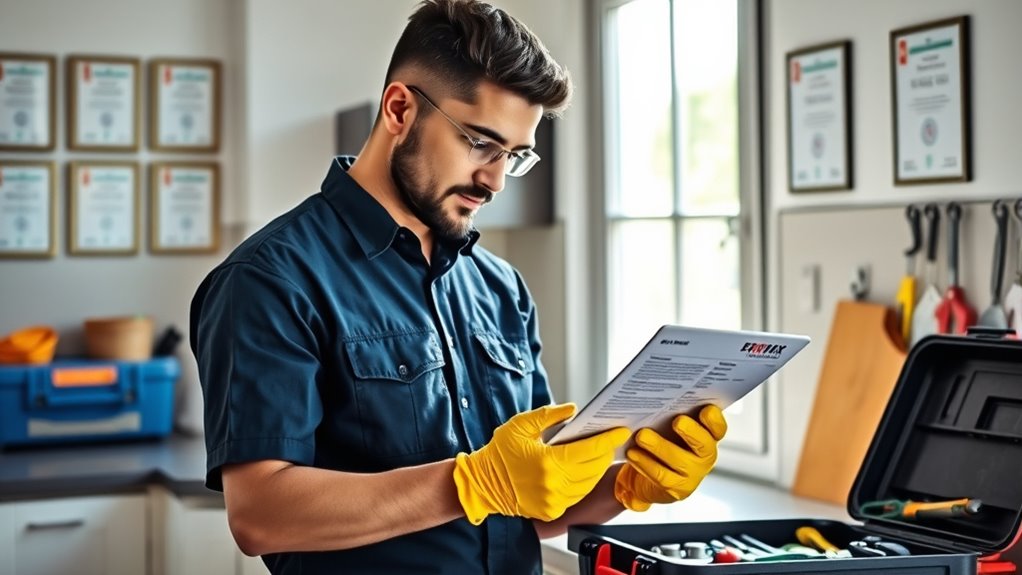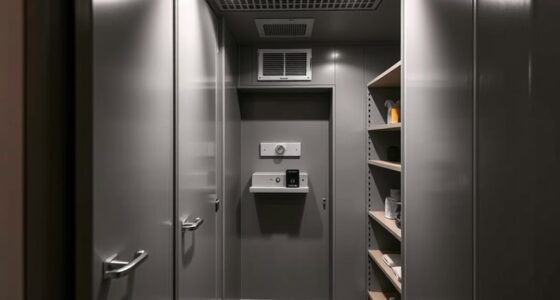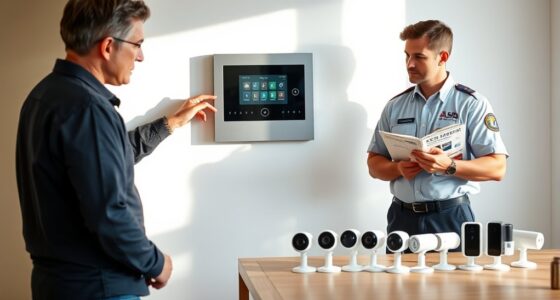To vet home service providers for safety, start by asking if they conduct detailed background checks, including criminal record searches and employment verification, and request proof of these screenings. Confirm they hold current, valid licenses and certifications, verifying through official state websites. Check their reputation by inquiring about ongoing training, performance monitoring, and safety policies. Stay transparent with documentation and communication, and regularly review credentials to guarantee ongoing security. Continue exploring these steps to ensure peace of mind.
Key Takeaways
- Verify that providers conduct comprehensive background checks, including criminal record searches and employment verification.
- Confirm that the provider holds current, valid licenses and certifications from official state agencies.
- Inquire about ongoing training, performance evaluations, and clear emergency response procedures.
- Request documentation of background screenings, licensing status, and safety protocols for transparency.
- Maintain regular communication, review credentials periodically, and monitor caregiver performance for ongoing safety.

Are you looking for convenient, reliable care for your veteran loved one without the stress of frequent visits to a facility? Finding the right home service provider is essential for peace of mind, but it’s equally important to thoroughly vet potential caregivers to guarantee safety and quality. The first step is to verify their background checks. Ask providers if they conduct detailed background screenings, including criminal history, employment verification, and references. These checks help you identify any red flags or past issues that could jeopardize your loved one’s safety. Don’t settle for vague assurances; request documentation or proof that these checks have been completed. A reputable provider will be transparent and enthusiastic to share this information, demonstrating their commitment to client safety.
Next, focus on licensing verification. Every legitimate home service provider must hold the appropriate licenses and certifications required by state and local authorities. These licenses ensure they meet specific standards for training, safety practices, and professionalism. Confirm that the provider’s licensing is current and valid, and ask about their compliance history. You can often verify licensing status online through state agencies or licensing boards. Avoid providers who are unlicensed or hesitant to share their credentials, as this could indicate a lack of proper oversight or training. Licensing verification is a critical step—it’s one of the clearest indicators that the caregiver has met minimum safety and competency standards.
In addition to background checks and licensing, consider asking about their hiring process. Find out if they perform ongoing training and monitor caregiver performance regularly. This ensures that your loved one receives consistent, high-quality care. Also, inquire about their policies for emergencies and how they handle complaints or concerns. A trustworthy provider will have clear procedures in place and be open to your questions.
Finally, trust your instincts and observe how the provider responds to your inquiries. Are they transparent, professional, and enthusiastic to provide documentation? Do they seem genuinely concerned about your loved one’s safety? If something feels off or you’re not satisfied with the answers, keep looking. Remember, vetting isn’t just a one-time process—it’s ongoing. Regularly reviewing credentials, checking in on licensing status, and maintaining open communication will help you feel confident that your veteran loved one is in safe hands. By taking these steps, you’re actively protecting their well-being while ensuring they receive the dependable, compassionate care they deserve.
Frequently Asked Questions
How Can I Verify a Provider’s Licensing Status?
You can verify a provider’s licensing status by checking with your state’s licensing board or website. Conduct background checks to guarantee their credentials are valid and current. Additionally, ask for proof of insurance verification to protect yourself from liability. Contact the licensing authority directly if needed, and review online reviews and references to confirm their legitimacy. Staying proactive helps you ensure the provider is properly licensed and trustworthy.
What Safety Certifications Should a Provider Have?
You should look for providers with safety certifications like OSHA, CPR, and First Aid, plus those who conduct thorough background checks and verify insurance. These certifications demonstrate their commitment to safety standards, while background checks and insurance verification guarantee they’re trustworthy and protected. When you choose a provider with these credentials, you’re more confident in their professionalism, safety practices, and accountability, giving you peace of mind in your home.
How Do I Check References or Reviews Effectively?
You should start by asking for references from previous clients and contact them directly to hear about their experiences. Check online reviews on trusted sites and look for consistent positive feedback. Don’t forget to verify background checks and confirm the provider has proper insurance coverage. This way, you guarantee the provider is reliable, trustworthy, and protected against potential liabilities, giving you peace of mind.
What Questions Should I Ask During the Interview?
You should ask about their background checks and insurance coverage to guarantee safety. Inquire if they’ve undergone thorough background checks and how often. Ask if they carry liability insurance and request proof of coverage. Clarify their experience with similar services and request references. These questions reveal their reliability, professionalism, and commitment to safety, helping you make a confident decision when choosing a home service provider.
How Can I Recognize Red Flags During Vetting?
You can recognize red flags during vetting by paying attention to incomplete background checks or reluctance to share references. If they lack proper insurance verification or hesitate to provide proof, that’s a warning sign. Also, watch for inconsistent answers or evasiveness about credentials. Trust your instincts and ask follow-up questions if something feels off. These signs help make sure you’re choosing a reliable, safe service provider.
Conclusion
By thoroughly vetting home service providers, you protect your home and loved ones. While it might seem time-consuming, doing your homework guarantees peace of mind and quality work. Remember, taking these steps now saves you from headaches and safety issues later. Don’t let hesitation hold you back—your safety is worth the effort. Trust your instincts, ask questions, and verify credentials. In the end, a little effort now keeps your home secure and stress-free.








